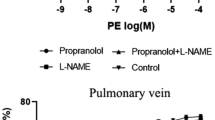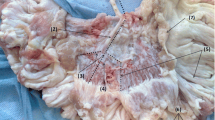Summary
Dihydroergocristine (DHEC) and dihydroergotamine (DHE) were investigated on canine saphenous veins in vivo and on canine saphenous veins and basilar arteries in vitro. Following local IV infusion in vivo, the venoconstrictor response to DHEC was about 30% weaker than that produced by DHE. When administered orally, however, both ergot alkaloids elicited similar venoconstrictor effects. In vitro maximal contractile responses to DHEC and DHE of basilar arteries were only 20–30% of those produced by 5-HT, whereas in saphenous veins both DHEC and DHE elicited similar maximal effects as those observed with 5-HT. In saphenous veins, methiothepin antagonized venoconstrictor responses to 5-HT, DHEC, and DHE within the same concentration range, being significantly less potent when tested against noradrenaline. The reverse was true for yohimbine, which was significantly more potent against noradrenaline than againificantly more potent against noradrenaline than against 5-HT, DHEC, and DHE. It is suggested that the venoconstrictor responses to both DHEC and DHE are mediated through 5-HT1-like receptors.
Similar content being viewed by others
References
Clark BJ, Chu D, Aellig WH.Actions on the heart and circulation. In: Berde B, Schild HO, eds. Berlin: Springer Verlag, 1978:231–420
Müller-Schweinitzer E. Alpha-adrenoceptors, 5-hydroxytryptamine receptors and the action of dihydroergotamine in human venous preparations.Naunyn Schmiedeberg's Arch Pharmacol 1984;327:299–303.
Müller-Schweinitzer E, Rosenthaler J. Dihydroergotamine: Pharmacokinetics, pharmacodynamics, and mechanism of venoconstrictor action in beagle dogs.J Cardiovasc Pharmacol 1987;9:686–693.
Schardt F, Polzien P. Hochdrucktherapie mit Briserin: Welche Rolle spielt die Dihydroergocristin-Komponente?Med Klin 1981;76:746–752.
Schardt F. Die orthostatische Dysregulation als Begleitphänomen der antihypertensiven Therapie: Die verschiedenen Präparateprofile. In: Bock KD, ed.Hochdrucktherapie im Alter mit Hydergin: Neue Gesichtspunkte Nüruberger Expertengespräche 1982, Schattauer Verlag, Stuttgart: 1983;57–69.
Müller-Schweinitzer E. The recording of venous compliance in the conscious dog. A method for the assessment of venoconstrictor agents.J. Pharmacol Methods 1984;12:53–58.
Müller-Schweinitzer E, Tapparelli C. Pharmacological studies on frozen stored canine saphenous veins and basilar arteries.Naunyn Schmiedeberg's Arch Pharmacol 1986; 332:74–78.
Müller-Schweinitzer E, Tapparelli C. Cryopreservation of isolated blood vessels for pharmacological studies: Experiments on canine and human veins. In: Nobin A, Owman C, Arneklo-Nobin, eds.Neuronal messengers in vascular function. Amsterdam: Elsevier Science Publishers (Biomedical Division), 1987:105–110.
Ebeigbe AB, Müller-Schweinitzer E, Vogel A. Effects of calcium channel blockade in canine saphenous veins after storage at −190°C.Br J Pharmacol 1988;94:381–388.
Müller-Schweinitzer E. Cryopreservation: A useful technique for storing tissues for pharmacological investigations.TIPS 1988;9:221–223.
Müller-Schweinitzer E. Agonist potencies of tryptamine derivatives at pre- and postjunctional receptors in canine saphenous vein.Postgrad Med J 1981;55(Suppl 1):36–44.
Müller-Schweinitzer E. Actions of co-dergocrine mesylate and its components at vascular smooth muscle.Naunyn-Schmiedeberg's Arch Pharmacol 1982;318:225–233.
Rorie DK, Muldoon SM, Tyce GM. The specific activity of retained and released noradrenaline in dog saphenous vein prelabeled with radiolabeled norepinephrine.Life Sci 1980;26:707–714.
Müller-Schweinitzer E. Pharmacological actions of the main metabolites of dihydroergotamine.Eur J Clin Pharmacol 1984;26:699–705.
Feniuk W, Humphrey PPA, Watts AD. Presynaptic inhibitory action of 5-hydroxytryptamine in dog isolated saphenous vein.Br J Pharmacol 1979;67:247–254.
Müller-Schweinitzer E. Studies on the peripheral mode of action of dihydroergotamine in human and canine veins.Eur J Pharmacol 1974;27:231–237.
Müller-Schweinitzer E. In vitro studies on the duration of action of dihydroergotamine.Int J Clin Pharmacol 1980;18:88–91.
Feniuk W, Humphrey PPA. A comparison of 5-hydroxytryptamine receptors mediating contraction of rabbit aorta and dog saphenous vein: Evidence for different receptor types obtained by use of selective agonists and antagonists.Br J Pharmacol 1985;86:697–704.
Paiva MQ, Caramona MM, Osswald W. The actions of 5-hydroxytryptamine receptor agonists and antagonists at pre- and postjunctional level on the canine saphenous vein.Naunyn-Schmiedeberg's Arch Pharmacol 1988;338:616–622.
Humphrey PPA, Feniuk W. Pharmacological characterization of functional neuronal receptors for 5-hydroxytryptamine. In: Nobin A, Owman C, Arneklo-Nobin B, eds.Neuronal messengers in vascular function. Amsterdam: Elsevier Science (Biomedical Division), 1987;3–19.
Humphrey PPA, Feniuk W, Perren MJ, et al. GR 43175, a selective agonist for the 5-HT1-like receptor in dog isolated saphenous vein.Br J Pharmacol 1988;94:1123–1132.
Bradley PB, Engel G, Feniuk W, et al. Proposals for the classification and nomenclature of functional receptors for 5-hydroxytryptamine.Neuropharmacol 1986;25:563–576.
Connor HE, Feniuk W, Humphrey PPA. Characterization of 5-HT receptors mediating contraction of canine and primate basilar artery by use of GR43175, a selective 5-HT1-like receptor agonist.Br J Pharmacol 1989;96:379–387.
Frenken M. Evidence for two populations of 5-hydroxytryptamine receptors in dog basilar artery.J Pharmacol Exp Ther 1989;250:379–387.
Müller-Schweinitzer E, Engel G. Evidence for mediation by 5-HT2 receptors of 5-hydroxytryptamine-induced contraction of canine basilar artery.Naunyn-Schmiedeberg's Arch Pharmacol 1983;324:287–292.
Author information
Authors and Affiliations
Rights and permissions
About this article
Cite this article
Müller-Schweinitzer, E. Venoconstrictor responses to dihydroergocristine and dihydroergotamine: Evidence for the involvement of 5-HT1 like receptors. Cardiovasc Drug Ther 4, 1455–1460 (1990). https://doi.org/10.1007/BF02026491
Issue Date:
DOI: https://doi.org/10.1007/BF02026491




